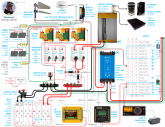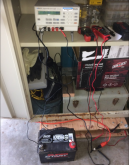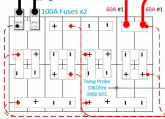LFP cells arrived this week so have updated my schematic w all the inputs I've received since my original version.
Here it is (click the pic in this link for a higher rez version):

Changes, in no particular order:
1. Panels connected on roof via Anderson Plugs. Only showing one for each panel pair but there will be four (like this) at the panels and one at the entry point to the inside of the camper (that head to each of my 3 DSSRs). They will be keyed (and color coded), which will prevent things getting plugged in the wrong places.
2. As for adding some kind of current protection at my panels (question I had on this post), it's occurred to me after reading this, that it's probably not possible (or needed?). Optimum Operating Current for my Renogy's is 9.32A. Short Circuit Current is less than .5A more (9.71). Guess that's why they call 'em "constant current." ;-)
3. Surge Protection: Lots of evolution on my part since my original post and the post in #2. Best protection against a direct hit? Keep the truck/camper isolated from Earth. As for surges from nearby strikes, have added the gas tube arrestors on each antenna coax and included an SPD at my bus bar. If I do take a direct hit (as I have in the past), well, there's just nothing to be done about it.
4. Swapped my isolated DC converter (neeed 2 of 'em) for the non-isolated one above. Here's my rationale for that swap.
5. Fuses at battery were on POS terminal but then got this from Dacian (Electrodacus) when he saw that:
6. Added a Disconnect Switch that will be accessible from the exterior of the camper to be able to quickly disconnect the battery should I need to (or when working in the electrical closet).
7. Related to #4, my original schematic had a 4 Channel Sonoff hanging off the 24V side of my DC converter, which would remain powered even after disconnecting the converter for LVC via EXTIO3. Oops! (And NO ONE caught that?? *grins*) With a lot more amps available w the new converter, I just moved all that to the 12V side and each have their own Sonoff SV switch (@24V, the original 10A 4 channel Sonoff was maxed; @12, I would have exceeded it 2x).
8. Spec'd all my breakers and wire sizes, and the Yagis. Wire and all associated bits and bobs and tools for wiring are now here. Just need to order the breakers and the antennas.
9. Have decided to go w a portable (vs inset) induction cooktop that I can use to cook outside the camper. Will likely rig up some kind of exterior outlet for this (one side of that double GFCI outlet for inside, one for outside). Similarly, will also likely wire a 12V external Anderson plug from my 12V panel for any outside 12V power needs I may have (it will be Red ... see #1, above).
10. Finally, added details for all my 12V consumers. This is the buck converter I will use and here's a link to video for converting Sonoff SV into Dry Contact Relay.
Will post separate thread for initial cell balancing that's about to commence. Picked up a pretty sweet used Fluke PM2811 linear power supply for $80. All it needed was a new fan, which I also found on eBay ($15 for 2). Swapped it out for the old one and tested it on an ancient car battery. Actually brought it back to life with some diligent CC and CV charging over the course of a couple of days. Super psyched!

Here it is (click the pic in this link for a higher rez version):

Changes, in no particular order:
1. Panels connected on roof via Anderson Plugs. Only showing one for each panel pair but there will be four (like this) at the panels and one at the entry point to the inside of the camper (that head to each of my 3 DSSRs). They will be keyed (and color coded), which will prevent things getting plugged in the wrong places.
2. As for adding some kind of current protection at my panels (question I had on this post), it's occurred to me after reading this, that it's probably not possible (or needed?). Optimum Operating Current for my Renogy's is 9.32A. Short Circuit Current is less than .5A more (9.71). Guess that's why they call 'em "constant current." ;-)
3. Surge Protection: Lots of evolution on my part since my original post and the post in #2. Best protection against a direct hit? Keep the truck/camper isolated from Earth. As for surges from nearby strikes, have added the gas tube arrestors on each antenna coax and included an SPD at my bus bar. If I do take a direct hit (as I have in the past), well, there's just nothing to be done about it.
4. Swapped my isolated DC converter (neeed 2 of 'em) for the non-isolated one above. Here's my rationale for that swap.
5. Fuses at battery were on POS terminal but then got this from Dacian (Electrodacus) when he saw that:
Disconnecting that battery switch will damage the current shunt amplifier inside the SBMS0. Same will happen if those fuses ever get damaged maybe by a short circuit.
All protection and disconnect should be after the current shunts not before ... or have that on the negative side.
N.B. for all those using SBMS ... do NOT allow POS side of battery to be disconnected when NEG is still connected!
All protection and disconnect should be after the current shunts not before ... or have that on the negative side.
N.B. for all those using SBMS ... do NOT allow POS side of battery to be disconnected when NEG is still connected!
6. Added a Disconnect Switch that will be accessible from the exterior of the camper to be able to quickly disconnect the battery should I need to (or when working in the electrical closet).
7. Related to #4, my original schematic had a 4 Channel Sonoff hanging off the 24V side of my DC converter, which would remain powered even after disconnecting the converter for LVC via EXTIO3. Oops! (And NO ONE caught that?? *grins*) With a lot more amps available w the new converter, I just moved all that to the 12V side and each have their own Sonoff SV switch (@24V, the original 10A 4 channel Sonoff was maxed; @12, I would have exceeded it 2x).
8. Spec'd all my breakers and wire sizes, and the Yagis. Wire and all associated bits and bobs and tools for wiring are now here. Just need to order the breakers and the antennas.
9. Have decided to go w a portable (vs inset) induction cooktop that I can use to cook outside the camper. Will likely rig up some kind of exterior outlet for this (one side of that double GFCI outlet for inside, one for outside). Similarly, will also likely wire a 12V external Anderson plug from my 12V panel for any outside 12V power needs I may have (it will be Red ... see #1, above).
10. Finally, added details for all my 12V consumers. This is the buck converter I will use and here's a link to video for converting Sonoff SV into Dry Contact Relay.
Will post separate thread for initial cell balancing that's about to commence. Picked up a pretty sweet used Fluke PM2811 linear power supply for $80. All it needed was a new fan, which I also found on eBay ($15 for 2). Swapped it out for the old one and tested it on an ancient car battery. Actually brought it back to life with some diligent CC and CV charging over the course of a couple of days. Super psyched!




